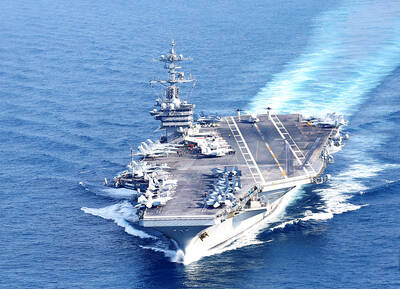The Chinese Ministry of Foreign Affairs yesterday reasserted Beijing’s right to develop its South China Sea island outposts following a US think tank report that China has built new radar facilities in the disputed Spratly Islands (Nansha Islands, 南沙群島).
Citing commercial satellite imagery, the Center for Strategic and International Studies (CSIS) said the radars on the Spratly Islands could be key to helping China establish effective control over the strategically vital area’s sea and airspace.
China has been building islands on top of reefs and atolls it controls, then adding air strips, harbors and other infrastructure that would help consolidate its control.
Taiwan, Vietnam, Brunei, Malaysia and the Philippines also have maritime claims that overlap with Beijing’s and the US has said it is concerned about China’s militarization of the area. Beijing rejects the accusations, saying it is merely installing defensive measures on islands, primarily for civilian purposes.
Ministry spokeswoman Hua Chunying (華春瑩) said she had no specific information about the CSIS report, but said China had undisputed sovereignty over the area.
“It’s within China’s sovereignty to carry out constructions on its own territories,” Hua told reporters at a regularly scheduled news conference in Beijing. “By deploying some necessary defensive facilities on the relevant islands and reefs it defends in the South China Sea, China is exercising the right of self-preservation that every country enjoys according to international law, which is beyond reproach.”
Hua reiterated charges that international media are paying too little attention to China’s construction of lighthouses, weather stations, fishermen’s shelters and other civilian infrastructure that Beijing portrays as public goods and services for the benefit of the international community.
She said China’s pursuit of peaceful development and good neighborly relations should not be called into question.
“China wants to make joint efforts with each side to keep the South China Sea peaceful and stable,” Hua said.
The CSIS report said the new radars would significantly bolster China’s ability to keep an eye on ship and aircraft traffic in the southern portion of the South China Sea, complementing its monitoring of the sea’s northern areas from existing facilities.
“Improved radar coverage is an important piece of the puzzle — along with improved air defenses and greater reach for Chinese aircraft — toward China’s goals of establishing effective control over the sea and airspace,” the report said.
The report comes a week after it was revealed that Beijing had deployed surface-to-air missiles in the Paracel Islands (Xisha Islands, 西沙群島), northwest of the Spratlys. The US said the presence of missiles provided increasing evidence of militarization of the area by China. China subsequently accused the US of militarizing the region, saying patrols by US Navy vessels and military aircraft had escalated tensions and raised concerns about stability in the area.
The South China Sea and ongoing tensions on the Korean Peninsula were expected to dominate yesterday’s talks between US Secretary of State John Kerry and Chinese Minister of Foreign Affairs Wang Yi (王毅).

CROSS-STRAIT COLLABORATION: The new KMT chairwoman expressed interest in meeting the Chinese president from the start, but she’ll have to pay to get in Beijing allegedly agreed to let Chinese Nationalist Party (KMT) Chairwoman Cheng Li-wun (鄭麗文) meet with Chinese President Xi Jinping (習近平) around the Lunar New Year holiday next year on three conditions, including that the KMT block Taiwan’s arms purchases, a source said yesterday. Cheng has expressed interest in meeting Xi since she won the KMT’s chairmanship election in October. A source, speaking on condition of anonymity, said a consensus on a meeting was allegedly reached after two KMT vice chairmen visited China’s Taiwan Affairs Office Director Song Tao (宋濤) in China last month. Beijing allegedly gave the KMT three conditions it had to

STAYING ALERT: China this week deployed its largest maritime show of force to date in the region, prompting concern in Taipei and Tokyo, which Beijing has brushed off Deterring conflict over Taiwan is a priority, the White House said in its National Security Strategy published yesterday, which also called on Japan and South Korea to increase their defense spending to help protect the first island chain. Taiwan is strategically positioned between Northeast and Southeast Asia, and provides direct access to the second island chain, with one-third of global shipping passing through the South China Sea, the report said. Given the implications for the US economy, along with Taiwan’s dominance in semiconductors, “deterring a conflict over Taiwan, ideally by preserving military overmatch, is a priority,” it said. However, the strategy also reiterated

‘BALANCE OF POWER’: Hegseth said that the US did not want to ‘strangle’ China, but to ensure that none of Washington’s allies would be vulnerable to military aggression Washington has no intention of changing the “status quo” in the Taiwan Strait, US Secretary of Defense Pete Hegseth said on Saturday, adding that one of the US military’s main priorities is to deter China “through strength, not through confrontation.” Speaking at the annual Reagan National Defense Forum in Simi Valley, California, Hegseth outlined the US Department of Defense’s priorities under US President Donald Trump. “First, defending the US homeland and our hemisphere. Second, deterring China through strength, not confrontation. Third, increased burden sharing for us, allies and partners. And fourth, supercharging the US defense industrial base,” he said. US-China relations under

The Chien Feng IV (勁蜂, Mighty Hornet) loitering munition is on track to enter flight tests next month in connection with potential adoption by Taiwanese and US armed forces, a government source said yesterday. The kamikaze drone, which boasts a range of 1,000km, debuted at the Taipei Aerospace and Defense Technology Exhibition in September, the official said on condition of anonymity. The Chungshan Institute of Science and Technology and US-based Kratos Defense jointly developed the platform by leveraging the engine and airframe of the latter’s MQM-178 Firejet target drone, they said. The uncrewed aerial vehicle is designed to utilize an artificial intelligence computer